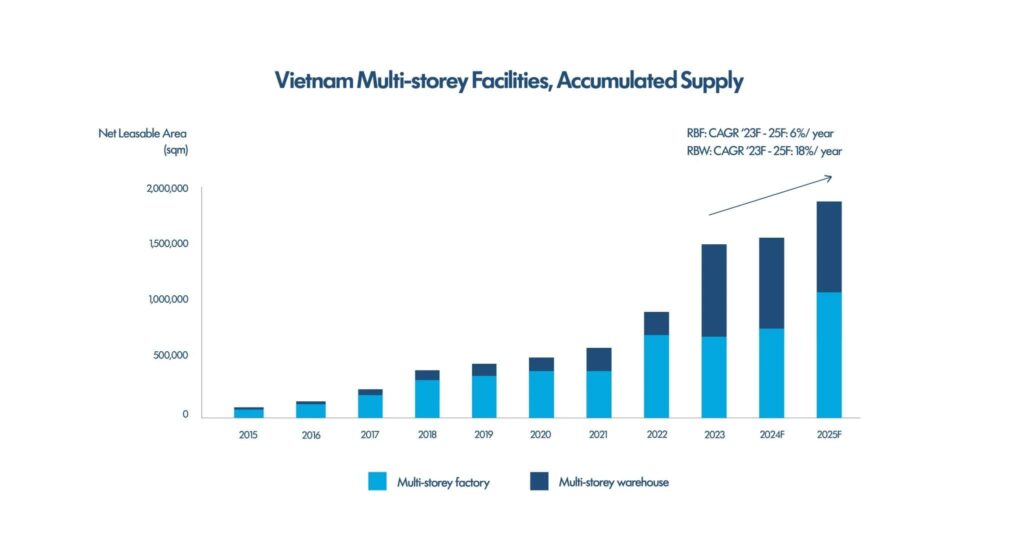사업 환경
Elevating Logistics: The Efficacy Of Multi-storey Facilities As Key Platforms In Vietnam
7월 1, 2024
Vietnam’s dynamic economic growth and rapid urbanization have catalyzed a remarkable transformation in the country’s logistics and supply chain infrastructure. As industries expand and consumer demands evolve, there is a pressing need to optimize logistics operations to meet the challenges of an increasingly interconnected global economy. In response to these demands, a concept has emerged on the logistics landscape: multi-storey facilities.
Current market situation of multi-story facilities
In Vietnam, metropolitan areas and provinces such as Ho Chi Minh City, Dong Nai, Binh Duong, Long An, Hai Duong, and Bac Ninh are witnessing a notable surge in the construction of multi-storey facilities, marking a significant shift in the country’s logistics landscape. This trend is driven by a combination of factors, including rapid urbanization, rising land prices, and increasing demand for efficient storage and distribution solutions in densely populated urban centres.

Accumulated Supply of Multi-Storey Facilities in Vietnam: 2015-2023 and Forecast for 2024-2025
Source: CBRE Research, The Future is Multi-Storey, May 2023
Since the first multi-storey facility to be developed in 2015, there have been more than 900,000 sqm from 15 facilities launched across the country. The total leasable area of multi-storey facilities is expected to double in the next 3 years with an addition of 10 new entrants.
At the end of 2022, by type of facility, Vietnam boasted a total of 513,957 sqm of leasing areas designed for high-rise factories, with a significant majority of 70% located in the Southern regions of the country. Concurrently, the supply of high-rise warehouses amounted to 457,479 sqm, all exclusively situated within the Southern areas of Vietnam.
While both multi-storey factories and warehouses share the characteristics of vertical construction, they serve different functions and cater to different types of businesses. Due to this dissimilarity, these 2 types of facilities serve distinguished segments of tenants.
Multi-story factories
High-rise factories are geared towards manufacturing and production activities of light and clean industries that require skilled workers, typically located in or near urban areas. Industries that are consumer-oriented like food processing, electronics assembly companies, fashion manufacturers, and so on are ideal tenants to lease high-rise factories. By locating in this type of facility, such businesses may benefit from several factors as follows:
- Space Optimization: Multi-storey factories allow tenants to maximize their use of limited land resources in urban areas.
- Proximity to Urban Centers: Being located closer to urban centers can provide tenants with easier access to labor pools, end consumers, and distribution networks.
- Flexibility and Vertical Scalability: Multi-storey factory spaces often offer flexible layouts and configurations, as well as the option to lease additional floors or expand the space, allowing tenants to adapt their operations as needed.
- Enhanced Security: Multi-storey factories typically feature controlled access points and security systems, providing tenants with a secure environment to conduct their operations and protect valuable equipment and inventory.
- Shared Amenities: Some multi-storey factory developments may include shared amenities such as common areas, meeting rooms, and recreational facilities, providing additional value beyond just the physical space.
Multi-storey warehouses
Warehouses, on the other hand, cater to e-commerce-related businesses where fast delivery is crucial. They serve as storage and distribution hubs for online retailers, wholesalers and logistics firms. Multi-storey warehouses offer the flexibility and convenience necessary for these businesses to thrive in densely populated urban environments in multiple ways:
- Vertical Storage Capacity: Multi-storey warehouses offer tenants increased storage capacity within a smaller footprint by stacking storage areas vertically.
- Efficient Material Handling: With multiple floors for storage, multi-storey warehouses can facilitate efficient material handling processes, including receiving, sorting, and picking operations.
- Proximity to Markets: Being located closer to urban centers and consumer markets can reduce transportation costs and lead times for order fulfilment.
- Customizable Space: Tenants may have the opportunity to customize their warehouse space to suit their specific storage requirements, including rack configurations, temperature controls, and specialized storage areas for different types of goods.
- Integrated Logistics Solutions: Some multi-storey warehouse developments may offer integrated logistics solutions, including value-added services such as packaging, labelling, and order fulfilment.
Overall, whether tenants are leasing space in a high-rise factory or warehouse, the key benefits include efficient space utilization, proximity to urban centers, flexibility, security, and access to shared amenities or integrated logistics solutions, all of which contribute to improved operational efficiency and competitiveness. Consequently, they are designed for businesses operating within light and clean industries serving the end-consumers in big cities.
Outlook of multi-storey facilities in Vietnam
The future of high-rise facilities for rent in Vietnam looks exceedingly promising, propelled by a confluence of factors. Foremost among these are the scarcity of industrial land and the escalating costs of prime real estate in strategic locations. This scarcity has driven developers and tenants to seek innovative solutions to optimize space utilization, leading to the rise of multi-storey warehouses.
Additionally, the demand from e-commerce-related tenants further fuels this development, as businesses strive to meet the evolving needs of urban consumers. As Vietnam’s economy continues to expand and e-commerce becomes increasingly pervasive, the demand for multi-storey facilities is poised to soar, solidifying their position as indispensable components of the country’s logistics infrastructure.







